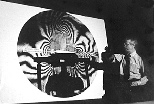President Charles Vest can't really hide his identity on campus, but he did manage to show up incognito one morning last week as a mystery guest lecturer in MAS450 (Holographic Imaging). Dr. Vest delivered a lecture on holographic interferometry, his field of research before administrative duties took over his calendar.
Professor Stephen Benton introduced the guest speaker to his class of mostly undergraduates as a "mechanical engineer who not too long ago was a practicing holographer. And then we all know what happened."
What happened is that he took the helm of MIT and left his personal research agenda behind. But he still gets to have a little fun now and then, talking about "the history of the field" and showing off some fascinating slides that utilized holographic images to measure changes to materials over time.
"Holographic interferometry as a field arose in a couple of months in three different groups around the world," Dr. Vest said. These people "thought about holograms they'd seen where somebody bumped the table" leaving an image overlaid by light and dark patches, called fringes. "Lots of people probably saw these and threw them away as bad holograms. But it turned out to be an improvement on techniques in another field: interferometry."
Traditional interferometry is a lab technique that uses high-precision measurements to test smooth optical surfaces such as lenses and mirrors. Researchers reflected light off objects, looking for small changes in either the wavefront or amplitude of the reflected light. With the advent of holography and the development of the laser, they were able to use interferometry to test rough, opaque, 3D objects by displaying changes to the phase of the reflected light over time, and providing a permanent record of the information.
Two of the most common applications of this technique were in the testing of aircraft tires and high-quality loudspeakers. Art restorers have also used it to evaluate the condition of ancient panel paintings. Holographic interferometry creates bull's-eye patterns indicating weak places in the bonding between canvas and paint (or points of delamination in tires).
But the best application discussed was just "for scientific curiosity and fun," said Dr. Vest about a project he undertook with J.D. Murray, an Oxford biologist interested in the mathematics underlying biology. Dr. Murray made mathematical models of the patterns in animal coats (stripes, spots, etc.) that result when chemicals in the embryonic skin diffuse through and chemically react to one another, giving rise to variations in fur color.
Dr. Murray discovered mathematically that it is "possible to have an animal that has spots on its body and rings on the tail. But not possible for the inverse to be true. It can't have rings on the thick part of its body and spots on the tail." Empirical data backs up this assertion, Dr. Vest explained while showing slides of thin, vibrating shells shaped like animals that provide an analog of the reaction-diffusion process, creating patterns resembling a striped animal with a spotted tail.
Dr. Vest's role in the research was in the creation of the images. Some of these images were published with an article by Dr. Murray inan issue of Scientific American in the early 1980s. "That was by far the most requested reprint I had anything to do with," Dr. Vest said.
After delivering his lecture, he opened up the floor for questions and comments from the students, who are learning to make their own holographic images in the class. "In my administrative capacity, I usually ask for criticisms, too," he said. But on this day, there was none.
A version of this article appeared in MIT Tech Talk on November 18, 1998.






